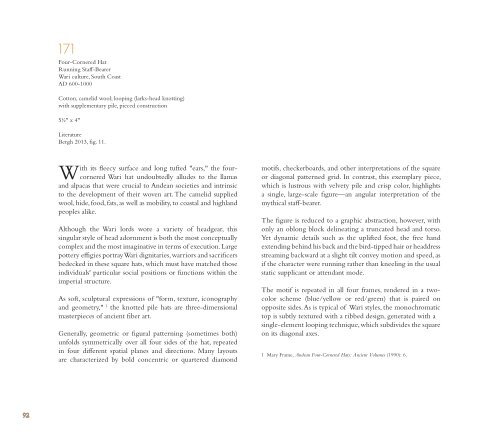You also want an ePaper? Increase the reach of your titles
YUMPU automatically turns print PDFs into web optimized ePapers that Google loves.
171<br />
Four-Cornered Hat<br />
Running Staff-Bearer<br />
Wari culture, South Coast<br />
AD 600-1000<br />
Cotton, camelid wool; looping (larks-head knotting)<br />
with supplementary pile, pieced construction<br />
5½" x 4"<br />
Literature<br />
Bergh 2013, fig. 11.<br />
With its fleecy surface and long tufted "ears," <strong>the</strong> fourcornered<br />
Wari hat undoubtedly alludes to <strong>the</strong> llamas<br />
and alpacas that were crucial to Andean societies and intrinsic<br />
to <strong>the</strong> development of <strong>the</strong>ir woven art. The camelid supplied<br />
wool, hide, food, fats, as well as mobility, to coastal and highland<br />
peoples alike.<br />
Although <strong>the</strong> Wari lords wore a variety of headgear, this<br />
singular style of head adornment is both <strong>the</strong> most conceptually<br />
complex and <strong>the</strong> most imaginative in terms of execution. Large<br />
pottery effigies portray Wari dignitaries, warriors and sacrificers<br />
bedecked in <strong>the</strong>se square hats, which must have matched those<br />
individuals' particular social positions or functions within <strong>the</strong><br />
imperial structure.<br />
As soft, sculptural expressions of "form, texture, iconography<br />
and geometry," 1 <strong>the</strong> knotted pile hats are three-dimensional<br />
masterpieces of ancient fiber art.<br />
Generally, geometric or figural patterning (sometimes both)<br />
unfolds symmetrically over all four sides of <strong>the</strong> hat, repeated<br />
in four different spatial planes and directions. Many layouts<br />
are characterized by bold concentric or quartered diamond<br />
motifs, checkerboards, and o<strong>the</strong>r interpretations of <strong>the</strong> square<br />
or diagonal patterned grid. In contrast, this exemplary piece,<br />
which is lustrous with velvety pile and crisp color, highlights<br />
a single, large-scale figure—an angular interpretation of <strong>the</strong><br />
mythical staff-bearer.<br />
The figure is reduced to a graphic abstraction, however, with<br />
only an oblong block delineating a truncated head and torso.<br />
Yet dynamic details such as <strong>the</strong> uplifted foot, <strong>the</strong> free hand<br />
extending behind his back and <strong>the</strong> bird-tipped hair or headdress<br />
streaming backward at a slight tilt convey motion and speed, as<br />
if <strong>the</strong> character were running ra<strong>the</strong>r than kneeling in <strong>the</strong> usual<br />
static supplicant or attendant mode.<br />
The motif is repeated in all four frames, rendered in a twocolor<br />
scheme (blue/yellow or red/green) that is paired on<br />
opposite sides. As is typical of Wari styles, <strong>the</strong> monochromatic<br />
top is subtly textured with a ribbed design, generated with a<br />
single-element looping technique, which subdivides <strong>the</strong> square<br />
on its diagonal axes.<br />
1 Mary Frame, Andean Four-Cornered Hats: <strong>Ancient</strong> Volumes (1990): 6.<br />
92







